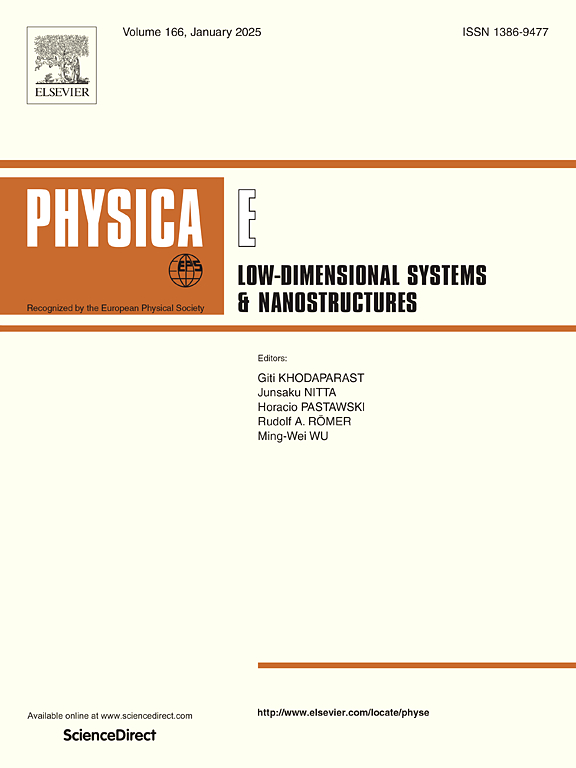Lateral electric field promotes the water transport in double-walled carbon nanotubes
IF 2.9
3区 物理与天体物理
Q3 NANOSCIENCE & NANOTECHNOLOGY
Physica E-low-dimensional Systems & Nanostructures
Pub Date : 2025-06-13
DOI:10.1016/j.physe.2025.116314
引用次数: 0
Abstract
A lateral electric field typically impedes the water transport in single-walled carbon nanotubes (SWCNTs), because it disrupts the hydrogen bond network among confined water molecules. In this work, through a series of molecular dynamics simulations, we observe an opposite phenomenon in double-walled carbon nanotubes (DWCNTs): the lateral electric field promotes the water transport. The underlying mechanism is that the hydrogen bond network can be partially breakdown by the lateral electric field, thereby melting the ice-like structures in DWCNTs, which facilitates water transport. Meanwhile, for the confined cylinder monolayer water, enhanced rotational motion under stronger field strengths can be more efficiently converted into translational motion. Specifically, as the field strength increases, the water flow increases almost linearly, corresponding to the decay in hydrogen bond number. With the increase in CNT length, the water flow exhibits a linear reduction and reaches completely zero at weak field strengths because of the formation of ice structures in long CNTs. Some other parameters, such as translocation time, occupancy number, and dipole and density distributions also show a specific dependence on the field strength and CNT length. These findings enrich our understanding of the unusual dynamics of water molecules in DWCNTs and shed light on a new idea for the design of novel nanofluidic devices.
横向电场促进双壁碳纳米管中水的输运
横向电场通常会阻碍单壁碳纳米管(SWCNTs)中的水传输,因为它会破坏封闭水分子之间的氢键网络。在本研究中,通过一系列分子动力学模拟,我们在双壁碳纳米管(DWCNTs)中观察到一个相反的现象:侧向电场促进了水的输运。其潜在机制是,横向电场可以部分击穿氢键网络,从而融化DWCNTs中的冰状结构,从而促进水的输送。同时,对于承压圆柱体单层水,在较强场强下,增强的旋转运动可以更有效地转化为平移运动。具体来说,随着场强的增加,水流量几乎呈线性增加,与氢键数的衰减相对应。随着碳纳米管长度的增加,由于长碳纳米管中冰结构的形成,水流量呈线性减少,在弱场强下达到完全零。其他一些参数,如易位时间、占用数、偶极子和密度分布也显示出对场强和碳纳米管长度的特定依赖。这些发现丰富了我们对DWCNTs中水分子不寻常动力学的理解,并为设计新型纳米流体器件提供了新的思路。
本文章由计算机程序翻译,如有差异,请以英文原文为准。
求助全文
约1分钟内获得全文
求助全文
来源期刊
CiteScore
7.30
自引率
6.10%
发文量
356
审稿时长
65 days
期刊介绍:
Physica E: Low-dimensional systems and nanostructures contains papers and invited review articles on the fundamental and applied aspects of physics in low-dimensional electron systems, in semiconductor heterostructures, oxide interfaces, quantum wells and superlattices, quantum wires and dots, novel quantum states of matter such as topological insulators, and Weyl semimetals.
Both theoretical and experimental contributions are invited. Topics suitable for publication in this journal include spin related phenomena, optical and transport properties, many-body effects, integer and fractional quantum Hall effects, quantum spin Hall effect, single electron effects and devices, Majorana fermions, and other novel phenomena.
Keywords:
• topological insulators/superconductors, majorana fermions, Wyel semimetals;
• quantum and neuromorphic computing/quantum information physics and devices based on low dimensional systems;
• layered superconductivity, low dimensional systems with superconducting proximity effect;
• 2D materials such as transition metal dichalcogenides;
• oxide heterostructures including ZnO, SrTiO3 etc;
• carbon nanostructures (graphene, carbon nanotubes, diamond NV center, etc.)
• quantum wells and superlattices;
• quantum Hall effect, quantum spin Hall effect, quantum anomalous Hall effect;
• optical- and phonons-related phenomena;
• magnetic-semiconductor structures;
• charge/spin-, magnon-, skyrmion-, Cooper pair- and majorana fermion- transport and tunneling;
• ultra-fast nonlinear optical phenomena;
• novel devices and applications (such as high performance sensor, solar cell, etc);
• novel growth and fabrication techniques for nanostructures

 求助内容:
求助内容: 应助结果提醒方式:
应助结果提醒方式:


